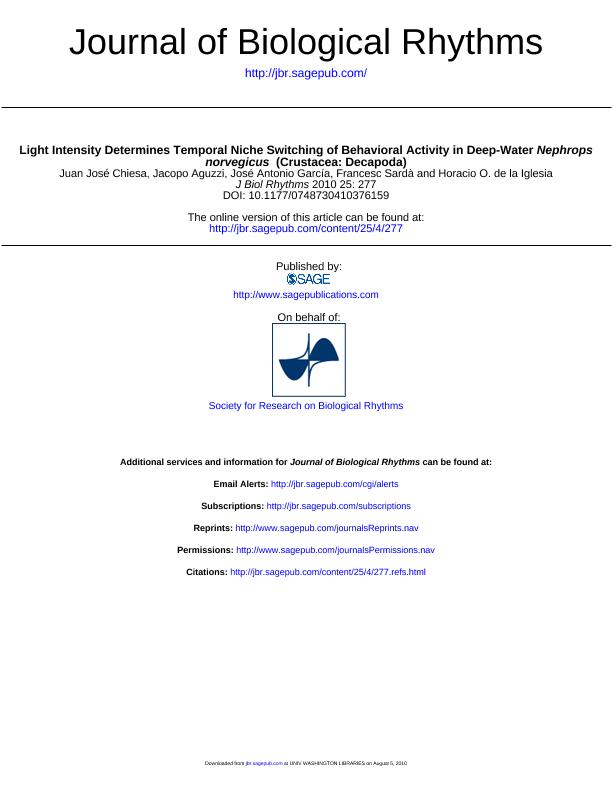Mostrar el registro sencillo del ítem
dc.contributor.author
Chiesa, Juan José

dc.contributor.author
Aguzzi, Jacopo
dc.contributor.author
García, José Antonio
dc.contributor.author
Sardà, Francesc
dc.contributor.author
de la Iglesia, Horacio Oscar

dc.date.available
2023-03-14T11:07:34Z
dc.date.issued
2010-08
dc.identifier.citation
Chiesa, Juan José; Aguzzi, Jacopo; García, José Antonio; Sardà, Francesc; de la Iglesia, Horacio Oscar; Light intensity determines temporal niche switching of behavioral activity in deep-water nephrops norvegicus (Crustacea: Decapoda); SAGE Publications; Journal of Biological Rhythms; 25; 4; 8-2010; 277-287
dc.identifier.issn
0748-7304
dc.identifier.uri
http://hdl.handle.net/11336/190425
dc.description.abstract
The temporal distribution of behavioral programs throughout the 24-h day, known as temporal niche of a species, is determined by ecological factors that directly affect the adaptive value of the timing of specific behaviors. Temporal niche switching has been described in several species and is likely adaptive in habitats where the daily timing of those factors changes. Benthic species whose habitats span a wide range of water depths are exposed to considerable depth-dependent environmental changes. Temporally scheduled trawl surveys of the Norway lobster, Nephrops norvegicus, reveal that animals emerge from burrows at night on the shallow shelf (10-50 m deep), at crepuscular hours on the lower shelf (50-200 m), and at daytime on the slope (200-400 m). The mechanisms underlying nocturnality/diurnality switches are chiefly unknown, and Nephrops offers a unique model for their study. The depth-dependent decrease in luminance is a likely candidate determining the temporal distribution of behavior. The authors explored this possibility in the laboratory by exposing Nephrops to light:dark (LD) cycles of 470-nm monochromatic lighting that mimic conditions at the 100-m-deep shelf (10 lux) or the 300-m slope (0.1 lux). Two groups of animals were respectively exposed to each light intensity according to the following protocol: an initial 12:12 LD stage followed by constant darkness (DD), followed in turn by a second 12:12 LD stage. Activity at the burrow opening (door-keeping = DK), as well as full emergence (E), was continuously monitored. Under 10-lux LD cycles, most animals showed nocturnal DK activity-with some being crepuscular or diurnal-and all animals showed nocturnal E activity. In contrast, both behaviors were clearly diurnal in animals under 0.1-lux LD cycles. The phase of the nocturnal and diurnal DK rhythms detected respectively at 10 and 0.1 lux upon release into DD revealed that these rhythms are entrained circadian rhythms. The present data indicate that nocturnality/diurnality switches in Nephrops in its natural habitat, evidenced by captures at different depths, are likely determined by light intensity. This temporal niche switching involves different patterns of photic entrainment, leading to bona fide circadian diurnal or nocturnal phenotypes, as well as exogenous masking of behavioral outputs.
dc.format
application/pdf
dc.language.iso
eng
dc.publisher
SAGE Publications

dc.rights
info:eu-repo/semantics/openAccess
dc.rights.uri
https://creativecommons.org/licenses/by-nc-sa/2.5/ar/
dc.subject
CIRCADIAN
dc.subject
DEEP SEA
dc.subject
ENTRAINMENT
dc.subject
INVERTEBRATES
dc.subject
MASKING
dc.subject
NEPHROPS NORVEGICUS
dc.subject.classification
Biología

dc.subject.classification
Ciencias Biológicas

dc.subject.classification
CIENCIAS NATURALES Y EXACTAS

dc.title
Light intensity determines temporal niche switching of behavioral activity in deep-water nephrops norvegicus (Crustacea: Decapoda)
dc.type
info:eu-repo/semantics/article
dc.type
info:ar-repo/semantics/artículo
dc.type
info:eu-repo/semantics/publishedVersion
dc.date.updated
2023-03-12T15:39:06Z
dc.journal.volume
25
dc.journal.number
4
dc.journal.pagination
277-287
dc.journal.pais
Estados Unidos

dc.description.fil
Fil: Chiesa, Juan José. Universidad Nacional de Quilmes. Departamento de Ciencia y Tecnología. Laboratorio de Cronobiología; Argentina. Consejo Nacional de Investigaciones Científicas y Técnicas; Argentina
dc.description.fil
Fil: Aguzzi, Jacopo. Consejo Superior de Investigaciones Científicas. Instituto de Ciencias del Mar; España
dc.description.fil
Fil: García, José Antonio. Consejo Superior de Investigaciones Científicas. Instituto de Ciencias del Mar; España
dc.description.fil
Fil: Sardà, Francesc. Consejo Superior de Investigaciones Científicas. Instituto de Ciencias del Mar; España
dc.description.fil
Fil: de la Iglesia, Horacio Oscar. University of Washington; Estados Unidos
dc.journal.title
Journal of Biological Rhythms

dc.relation.alternativeid
info:eu-repo/semantics/altIdentifier/url/https://journals.sagepub.com/doi/10.1177/0748730410376159
dc.relation.alternativeid
info:eu-repo/semantics/altIdentifier/doi/http://dx.doi.org/10.1177/0748730410376159
Archivos asociados
